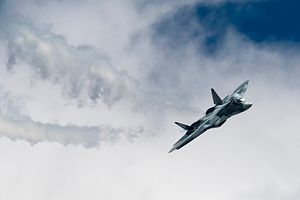The first batch of Sukhoi Su-57 fighter aircraft, Russia’s first indigenously designed and built fifth-generation stealth fighter jet, will be delivered to the Russian Air Force according to schedule in late 2019, Deputy Russian Defense Minister Alexei Krivoruchko announced last week. The Su-57 is a multirole, single seat, twin-engine air superiority/deep air support fighter developed under the PAK-FA fifth-generation fighter program.
The deputy defense minister did not elaborate on the number of aircraft set to be delivered, although in the past senior Russian defense officials have repeatedly referred to a pre-production batch of 12 Su-57s. A contract for the 12 aircraft was expected to be signed during the 2018 Army Forum, an annual event organized by the Russian Ministry of Defense (MoD) to showcase Russian-made military hardware, in August.
However, despite some media reports to the contrary, no public announcement about the inking of a contract has been made to date by the MoD. Indeed, Deputy Prime Minister Yury Borisov, overseeing Russia’s defense industry, has stopped referring to the 12 aircraft, noting that “the Su-57 is part of the state armaments program for 2018-2025 (…) an exact number of them cannot yet be specified.”
According to Russian media reports, the actual number of aircraft delivered by the end of 2020 — rather than 2019 — could be just two. (The Russian Air Force is currently operating 10 Su-57s prototypes for evaluation and testing.) It is likely that Krivoruchko was referring to these two aircraft in his statement last week. Consequently, the delivery of two aircraft in late 2019 or early 2020 appears to be the most likely scenario.
Notably, the Russian MoD announced in July that the Su-57 will not enter serial production in the near future. Originally, the Su-57 was slated to replace the Russian Air Force’s existing stock of MiG-29s and Su-27s by the end of the 2020s, with plans to induct up to 150 aircraft during that decade. This was later revised to 55 Su-57s. An amalgamation of budgetary deficits, shifting defense priorities, and numerous technical problems are the most likely explanation for the Russian Air Force’s reduced future fleet of Su-57s.
For example, the Russian military aviation industry continues to struggle with a next-generation engine for the aircraft. A new engine — reportedly called the Saturn izdeliye 30, boasting increased thrust and fuel efficiency and fitted with 3D thrust vectoring nozzles — is not expected to be ready for serial production until at least 2020. Acceptance tests of the new engine are expected to begin in early 2019 following its successful integration on the Su-57 in the coming months. (Two Su-57s deployed to Syria for combat operations this summer were fitted with older engines.)
































